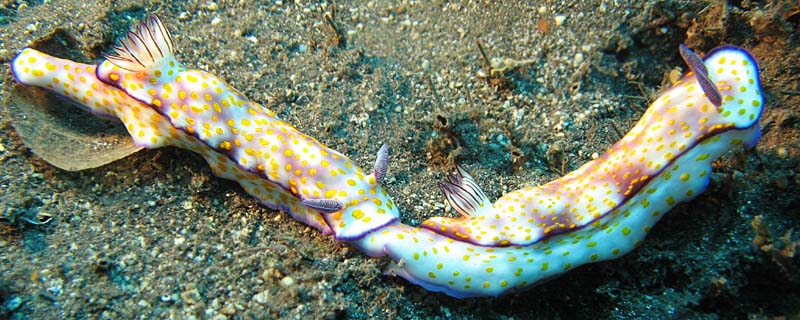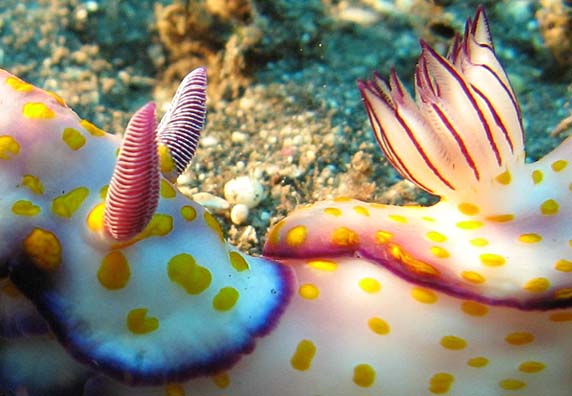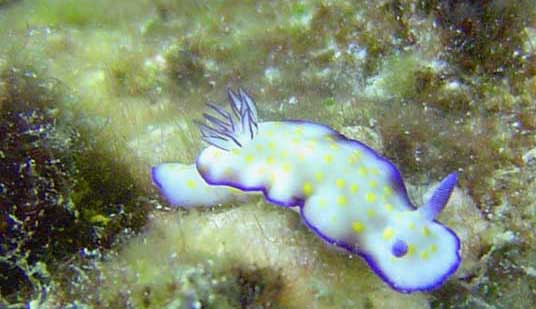This species has been observed on Reunion, Mayotte, Mauritius, Madagascar and Seychelles Islands
The mantle is white or creamy white with numerous small yellow orange spots. |

|
|
| Showing species characteristics... | Photo Sophie Darnis Reunion, "Sec Zitte" at Saint Leu, 28 May 2006, size : 30 mm |
|
See more about : Sightening and mating periods
See more about : Hypselodoris pulchella variability in Southwest Indian ocean
Remarks :
Identification confirmed by Nathalie Yonow and Hsini Lin
Synonymous : (according Worms)
- Chromodoris pulchella, (Rüppell & Leuckart, 1830)
- Doris pulchella, Rüppell & Leuckart, 1830
- Risbecia pulchella, (Rüppell & Leuckart, 1830)
Bibliographic data :
Material examined by Bill Rudman (1986)
A specimen from Reunion Island (St Gilles reef, September 1976) was identified from a photograph from the Paris Museum (Jay Collection, lot 26)
Other external morphology characteristics
The front of the mantle forms a veil which continuously waves up and down when crawling.
The gills are often branched and wave rhythmically from side to side.
The edge of the mantle has a thin band of light bluish purple and there are a serie of irregular purple patches around the edge, about four between the gills and the rhinophores on each side and two or three around the posterior end
The underside of the mantle is white with yellow orange spots and there is a light purple border somewhat wider than dorsally and of irregular width.
The sides of the body and the foot are white with yellow-orange spots and the foot has a light bluish purple border. There are traces of the pale watery reticulate pattern on the dorsal posterior part of the foot.
When recently spawned, the egg ribbon is reddish orange and it is attached along one edge in a spiral, the free edge being slightly wavy.
The characteristic trailing behaviour, where pairs of animals are often found following each other in single file, the second animal in the line usually touching the 'tail' of the one in front.
In the western Pacific there is another species, Hypselodoris imperialis, which differs externally in the absence of the purple border to the foot and the smudged purple reticulate pattern found on the dorsum, and another difference is that Hypselodoris imperialis is creamy white with a dark blue mantle border.
Originally described from the Red Sea, where it coexists with the similarly coloured Hypselodoris ghardaqana and Goniobranchus annulatus.
Hypselodoris pulchella |
Hypselodoris ghardaqana |
||
| Maximun size | 110mm x 30 mm | 55 mm x 13 mm | 64 mm x 20 mm |
| Colour of dorsum | Opaque creamy white with purple patches in irregular areas, strewn with yellowish orange spots | Milky white with yellow spots (much fewer in number ) without purple patches | Translucent white with yellow spots, and two violet rings |
| Rhinophore club | Long, purple with white axis | Short, reddish violet, with pink red axis | Long, conical, deep purple |
| Mantle margin | Bluish violet | Deep blue | Deep purple |
| Gills | 20-30, often branched, almost vertical, vibratile | 9-11, never branched, horizontal and non-vibratile | 9-12, vertical and vibratile |
| Egg ribbon | Reddish orange, the free edge is wavy | White, the free edge is slightly wavy, single layer of eggs | Creamy white, with yellow pigment in spawn jelly, the free edge is not wavy |
References :
Bill Rudman Seaslug site : Sea Slug Forum : Risbecia pulchella
Nudipixel Risbecia pulchella
Publications :
Gohar, H. A. F., & I. A. Aboul-Ela. 1957a. The development of three chromodorids (with the description of a new species). Publications of the Marine Biological Station, Al-Ghardaqa, Egypt, 9 : 203-228, pls. 1-5.
Johnson R.F. & Gosliner T.M. (2012) Traditional taxonomic groupings mask evolutionary history: A molecular phylogeny and new classification of the chromodorid nudibranchs. PLoS ONE 7(4): e33479.
Rudman, W.B. (1984) The Chromodorididae (Opisthobranchia: Mollusca) of the Indo-West Pacific: a review of the genera. Zoological Journal of the Linnean Society, 81 : 115-273.
Rudman, W.B. (1987) The Chromodorididae of the Indo-West Pacific: Chromodoris epicuria, C. aureopurpurea, C. annulata, C. coi and Risbecia tryoni colour groups. Zoological Journal of the Linnean Society, 90 : 305-407.
Other photos of Hypselodoris pulchella :
 |
|
Stéphan Aubert Reunion, Saint Gilles near "tour de Boucan-Canot" The characteristic trailing, where pairs of animals are often found following each other in single file, the second animal in the line usually touching the 'tail' of the one in front. The rhinophore stalk is white and the club deep purple with white edging to the lamellae and a white median line up the anterior and posterior midlines
|
 |
 |
Maurice Jay
Reunion, "Cap la Houssaye" at Saint Paul, 15 m, size : 60mm There is also an open reticulate of pale watery purple all over the mantle |
Philibert Bidgrain Mayotte, M'boueanatsa, less 1 m, 26 July 2010, size : 60 mm
The rhinophore stalk is white and the club deep purple with white edging to the lamellae and a white median line (a) up the anterior and posterior midlines There is also an open reticulate of pale watery purple (b) all over the mantle
|
 |
Emmanuel Eby Reunion, Saint Leu, size 20 mm, 17 November 2004
|
 |
 |
Sully Bachel Reunion, Cap la Houssaye, Saint Paul, 10 m, 4 April 2009, size : 40 mm. (a) The underside of the mantle is white with yellow orange spots and there is a light purple border somewhat wider than dorsally and of irregular width. (b) Oral tentacle |
More photos from Indian Ocean
See more about : Hypselodoris pulchella variability in Southwest Indian ocean
Mauritius, Hypselodoris pulchella, at Récif des murènes, by Mathieu Bayon
Reunion, Hypselodoris pulchella trailing behavior, at Saint Leu, by Delphine Dupin
Reunion, Hypselodoris pulchella side by side, at Saint Leu, by François Beudard
Reunion, five Hypselodoris pulchella, at Saint Paul, by Sully Bachel
Reunion, Hypselodoris pulchella trailing behavior, at Saint Leu, by Céline Tasset et Yvon Laurelut
Mayotte, Hypselodoris pulchella trailing behavior, at Grand récif N.E, by Patrick Frouin
Mayotte, Hypselodoris pulchella, at M'Bouini, by Matthias Deuss
Madagascar, Hypselodoris pulchella trailing behavior, at Antongil, by Olivier Fournajoux
Seychelles, Hypselodoris pulchella trailing behavior, at Mahé, by Christophe Mason-Parker
Mayotte, a pair of Hypselodoris pulchella, at Dzaoudzi, by Philibert Bidgrain